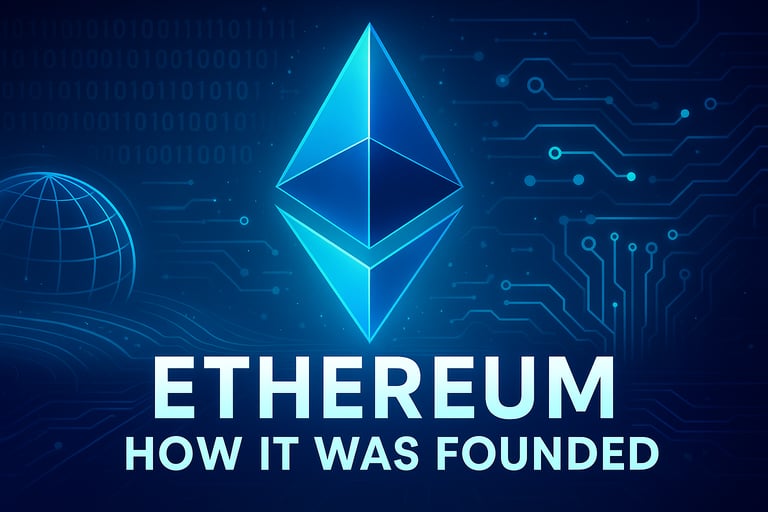The Birth of Ethereum: How the Network That Changed Crypto Forever Was Founded – With DropFinder Insight
Discover the fascinating story of how Ethereum was founded — from Vitalik Buterin’s revolutionary idea to its global dominance in blockchain innovation. Learn how it transformed crypto beyond Bitcoin, paving the way for smart contracts, DeFi, NFTs, and more — with insights powered by DropFinder.
CRYPTO NEWS
10/9/20256 min read
Introduction: The Revolution Beyond Bitcoin
When Bitcoin launched in 2009, it introduced a groundbreaking idea — a decentralized currency outside government control. But as the crypto community matured, one question arose: What if blockchain could do more than just handle money?
That question ignited the birth of Ethereum, a blockchain network that reshaped how we see digital ownership, decentralized finance, and smart contracts.
Today, Ethereum stands as the foundation for thousands of crypto projects, decentralized applications (DApps), and tokens — including many featured on DropFinder, where users track the latest airdrops and blockchain launches.
But how did this revolutionary network begin? Let’s explore the fascinating origin of Ethereum — from the vision of a young coder to one of the most powerful ecosystems in the digital world.
1. The Spark of an Idea: Vitalik Buterin’s Vision
The Ethereum story begins with Vitalik Buterin, a Russian-Canadian programmer and writer born in 1994. A math prodigy with a passion for technology, Vitalik discovered Bitcoin at age 17.
In 2011, he co-founded Bitcoin Magazine, writing deeply analytical articles that helped shape the public’s understanding of cryptocurrency. But even while studying Bitcoin, Vitalik saw its limits.
Bitcoin was brilliant at secure, decentralized transactions — but it wasn’t flexible. Developers couldn’t easily build applications on top of it.
Vitalik believed blockchain could evolve into something bigger — not just money without banks, but a platform without middlemen.
In 2013, he wrote a now-famous whitepaper outlining Ethereum — a blockchain designed to run “smart contracts,” self-executing agreements that would eliminate intermediaries in everything from finance to real estate.
2. The Ethereum Whitepaper and the First Supporters
Vitalik’s whitepaper spread quickly through the crypto community. The idea of programmable money fascinated developers worldwide.
A group of early pioneers soon joined him to bring Ethereum to life. Among them were:
Gavin Wood – A computer scientist who would later create the Ethereum “Yellow Paper,” defining its technical specifications.
Joseph Lubin – A Canadian entrepreneur who would go on to found ConsenSys, a major blockchain development company.
Anthony Di Iorio – An early Bitcoin investor who provided vital early funding.
Charles Hoskinson – A mathematician who later founded Cardano.
Mihai Alisie – Co-founder of Bitcoin Magazine and early Ethereum organizer.
Together, they formed the core Ethereum founding team, united by a shared goal — to build a blockchain that could power anything, not just payments.
3. The Birth of the Ethereum Foundation
To manage the project’s growth and funding, the founders created the Ethereum Foundation in 2014, a non-profit based in Switzerland.
The foundation’s goal was to guide Ethereum’s development, promote its ecosystem, and ensure transparency in its launch.
But launching a new blockchain wasn’t easy. They needed capital. So they turned to a novel funding method — one that would later inspire the ICO boom.
4. The 2014 Crowdsale: Crypto’s First Big Fundraiser
In mid-2014, the Ethereum team launched a crowdsale, allowing people to buy Ether (ETH) — the native token of the Ethereum network — using Bitcoin.
This was one of the first large-scale Initial Coin Offerings (ICOs) in crypto history.
The sale lasted 42 days and raised over 31,000 BTC, worth around $18 million at the time — a massive amount for a blockchain project.
It showed the world that Ethereum had not just a strong vision, but also real support from the growing crypto community.
5. The Frontier Launch: Ethereum Goes Live
After the successful funding round, the development team worked tirelessly to bring the network to life.
Finally, in July 2015, Ethereum launched its first version, called Frontier.
It was the dawn of a new era — a public blockchain that could execute smart contracts and host decentralized applications (DApps).
This version was raw and experimental, designed primarily for developers and early adopters to test the system.
Ethereum quickly became a hub for innovation — developers began building tokens, games, decentralized finance platforms, and more.
The possibilities were endless — and for the first time, blockchain technology felt like it could power an entire digital world.
6. The DAO and the Infamous Hack
With innovation came risk. In 2016, a major project called The DAO (Decentralized Autonomous Organization) launched on Ethereum.
It was a bold experiment — a decentralized venture fund that let investors vote on which projects to support. The DAO raised over $150 million in Ether, becoming one of the biggest crowdfunding events in history.
But disaster struck.
A hacker exploited a flaw in The DAO’s smart contract and siphoned off $50 million worth of ETH.
The Ethereum community faced a crisis — should they reverse the hack or let it stand, preserving blockchain’s “immutable” nature?
After intense debate, the majority chose to hard fork the blockchain, rolling back the hack and restoring stolen funds.
However, not everyone agreed. The dissenters continued the original chain, creating Ethereum Classic (ETC) — while the main network continued as Ethereum (ETH).
This event tested the community’s ethics but also showed Ethereum’s resilience and unity in the face of turmoil.
7. Ethereum’s Rise: The Era of Smart Contracts and ICOs
Following the DAO controversy, Ethereum began its ascent to dominance. Developers worldwide embraced its smart contract capabilities.
Between 2016 and 2018, Ethereum became the foundation for hundreds of startups, launching their own tokens through ICOs.
This boom led to massive investment in blockchain innovation — everything from gaming to real estate and healthcare began experimenting with Ethereum’s technology.
Some projects succeeded spectacularly; others failed or were fraudulent. But the Ethereum ecosystem continued to expand, proving that its open-source model could empower anyone to build the next big idea.
8. Ethereum 2.0: The Quest for Scalability and Sustainability
As Ethereum’s popularity grew, so did its challenges. The network began to face scalability issues — transactions slowed down, and gas fees soared.
To solve this, developers began designing Ethereum 2.0 (also called the “Consensus Layer”), an upgrade to transition from Proof-of-Work (PoW) to Proof-of-Stake (PoS).
This upgrade aimed to make Ethereum faster, more efficient, and environmentally friendly.
In September 2022, after years of preparation, Ethereum completed The Merge — successfully switching to Proof-of-Stake, reducing energy consumption by over 99%.
This was one of the most significant milestones in blockchain history and reaffirmed Ethereum’s place as the most advanced and sustainable smart contract platform.
9. The World Built on Ethereum
Today, Ethereum is much more than a cryptocurrency. It’s an entire digital ecosystem powering:
DeFi (Decentralized Finance): Platforms like Uniswap, Aave, and Compound run on Ethereum.
NFTs (Non-Fungible Tokens): Art, music, and collectibles all use Ethereum’s ERC-721 standard.
DAOs (Decentralized Autonomous Organizations): Modern organizations governed by code.
Gaming & Metaverse: Projects like Decentraland and Axie Infinity are built on Ethereum.
Airdrops & Tokens: Thousands of new coins and airdrop projects — many featured on DropFinder — are launched every year using Ethereum’s ERC-20 token standard.
Ethereum’s flexibility allows anyone to create and deploy new crypto projects — and airdrops remain one of the most exciting ways users can earn tokens from innovative startups.
10. The Role of DropFinder in Ethereum’s Ongoing Evolution
As Ethereum continues to power new projects and airdrops, DropFinder has become a vital platform for discovering them.
DropFinder tracks legit, upcoming, and active airdrops, many of which are built on the Ethereum blockchain.
From governance tokens to DeFi rewards, Ethereum remains the backbone of most airdrop campaigns because of its security, reliability, and massive developer base.
So if you’re exploring which airdrops to invest in or participate in 2026, Ethereum-based projects are often the safest and most promising — and DropFinder helps you find them before they explode in popularity.
11. Ethereum’s Founders Today
The original Ethereum team members have each gone on to shape crypto in their own way:
Vitalik Buterin continues as Ethereum’s philosophical and technical leader, guiding its evolution.
Gavin Wood founded Polkadot, another major blockchain aiming for interoperability.
Charles Hoskinson created Cardano, a rival smart contract platform.
Joseph Lubin built ConsenSys, a global blockchain software company.
Their contributions collectively helped shape a multi-chain future — but Ethereum remains the heart of it all.
12. Lessons from Ethereum’s Journey
Ethereum’s story is more than a tale of technology — it’s a story of vision, community, and resilience.
From a 19-year-old’s whitepaper to a trillion-dollar ecosystem, Ethereum’s rise shows what’s possible when innovation meets decentralization.
Key lessons include:
Innovation thrives without permission: Ethereum proved anyone can build world-changing tech.
Community matters: Its success came from collective effort, not a single company.
Transparency and adaptability are vital: Even after hacks and forks, Ethereum evolved stronger.
As the crypto world enters 2026, Ethereum continues to lead in innovation, sustainability, and trust.
13. The Future of Ethereum and Airdrops
Looking ahead, Ethereum is preparing for further upgrades like Danksharding and Layer 2 scaling, which will make transactions faster and cheaper.
These improvements will fuel even more airdrop opportunities, as new projects launch on Ethereum’s scalable infrastructure.
For crypto enthusiasts and investors, tracking these early projects on platforms like DropFinder is the best way to stay ahead of the next wave of decentralized innovation.
Conclusion: The Network That Redefined the Internet
From a young developer’s dream to a global movement, Ethereum changed everything.
It turned the blockchain into a universal computer, capable of powering financial systems, art, governance, and even games — all without centralized control.
As we move deeper into 2026, Ethereum continues to stand tall as the world’s most influential blockchain — the birthplace of DeFi, NFTs, DAOs, and countless airdrops.
And with DropFinder guiding users through this ever-evolving ecosystem, finding the next big Ethereum project has never been easier.
In short: Ethereum wasn’t just founded — it was forged through innovation, collaboration, and an unshakable belief in decentralization. Its story isn’t over; it’s just getting started.
With every new upgrade, token, or airdrop, Ethereum continues to push the boundaries of what’s possible — and the next chapter of crypto innovation will almost certainly be written on its blockchain.




